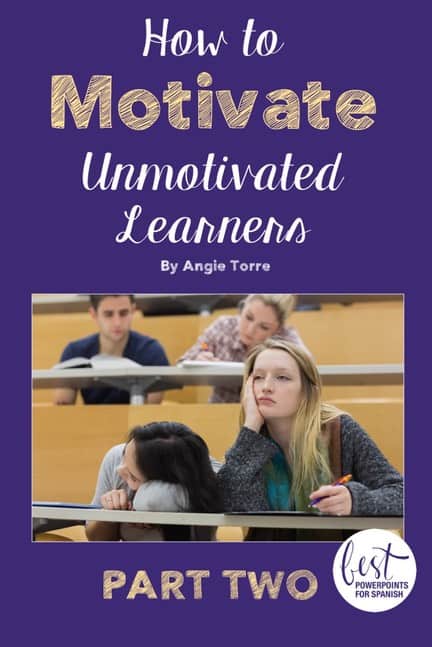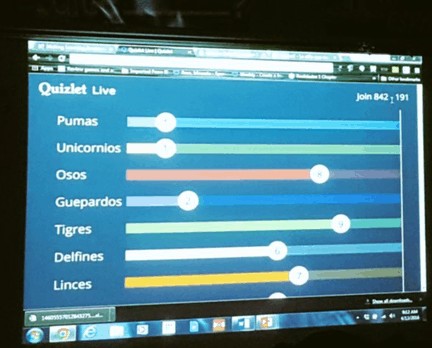How to Motivate Unmotivated Learners – Part Two
As soon as the students get accustomed to the classroom procedures, they will be more motivated. As soon as I get some (better) T.A.s, the class will run more smoothly. As soon as …. One day I realized that motivating and challenging students to do more than they thought they could was a DAILY TASK, that every day I will be tested and required to show students that the bar is up here, not down here. So, every day, I pull strategies out of my teacher bag to engage and motivate students. Here are a few that have brought my students to proficiency.

How to Motivate Students
TIP # 1 Wait Time
Wait time is necessary, of course, to give students time to process the question and to form a response in a language not their own. However, it also provides a bit of suspense, what I call, “good tension”. If I say the name of the student, and then ask the question, 99% of the class is off the hook and tempted to look at their phones. If I say the question first, then pause, pause, pause, while giving eye contact to each student in the room ALL students are engaged because they might be the one called upon to answer.
TIP # 2 Include All Students
Closure activities should include ALL students. Which activity should I choose, “Fly Swatter, Jeopardy,” or “Tic Tac Toe?” I use the one that engages ALL students. My Go-To competition is Team A against Team B in which each student is given a number. I project or say the question, pause, and call a number. Every student is on alert because his number may be the one called. Another good closure activity is Quizlet Live because it not only engages all students, it is hands-on.
TIP # 3 Choose Hands-on Activities
Choose activities that are hands-on or use as many senses as possible. Passivity is replaced by enthusiasm when students stand, run, type, dramatize. I can’t force all my students to act out the vocabulary with me, but they WANT to tap away during Quizlet Live, Kahoot, Google Drive activities and other games that involve both hands or movement. Here is a blog by teacher Sra. Shaw about Quizlet Live if you would like to know more. (Students do not have to sit together. Teaching them how to say, “Lo tengo” and, “No lo tengo”ensures students stay in the target language while collaborating with their group members.)

Quizlet Live
The night before, I assign homework on Quizlet. The next day, we play the game. Here is the Quizlet Live we played.
TIP # 4 Use student Photos in your PowerPoints
Use student pictures in your PowerPoints and the names of your students in your activities. As soon as students see their photo on the screen, they are immediately attentive.
TIP # 5 Hold Students Accountable
Hold students accountable for completion of and quality of homework. I know there is research that argues that homework doesn’t produce proficiency. However, my empirical evidence proves otherwise.
I doubt those studies take into account the TYPE of homework assigned and whether or not the teacher grades the homework on quality.
I tell my students I never assign homework unless we have first thoroughly practiced the concept in class. However, when they do it, I first grade for completion only, checking to see who did it and who didn’t. If a student did not do the homework (because of reasons other than absence) he/she may (and must) do it during tutorial. If the student does not come to tutorial, he/ she is assigned 30 minutes tutorial, then a Saturday School. The first two weeks, my board is covered with the names of students who did not do homework. By week three, the list is considerably smaller as students begin to realize there is a consequence for not doing the homework.
After partners correct the homework students turn it in again. This time, my assistants grade it for quality. The students who do quality work get high grades AND become proficient. Of course, the homework must be as proficiency-based as possible. By that I mean, not as much drill, and more real language.
For example, instead of a translation activity for adjectives, have students describe visuals using adjectives they have learned or ask real questions they must answer.
In the next blog I will share a few more ideas that have kept my students hopping. Stay tuned for PART THREE of HOW TO MOTIVATE UNMOTIVATED LEARNERS. There are so many effective strategies I couldn’t fit them all into one blog.
In case you missed part one click HERE.
If you have any ideas about how to motivate students I would love to hear them. Feel free to share on this blog or on my Facebook page: Best PowerPoints for Spanish
If you find these tips useful and know other teachers who would benefit from subscribing to this newsletter, share this blog with them. They can subscribe on the home page (Make sure to scroll down to the bottom):
To receive freebies and notifications of new products, click here to FOLLOW MY STORE.


